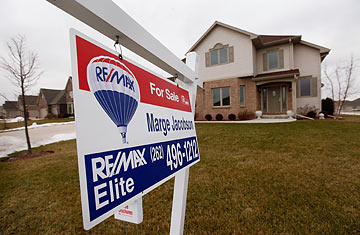
A home for sale in Pleasant Prairie, Wis.
Is the option adjustable-rate mortgage the next subprime disaster? For anyone who remembers that souring subprime loans kicked off the real estate meltdown, that's a scary thought. Recent analysis from Standard & Poor's (S&P) anticipates that a full 37.5% of such loans (dubbed option ARMs) that were written in 2007, at the height of lax lending, will eventually go bad. The kicker is that most option ARMs undergo payment spikes after five years, which means the brunt of the impact has yet to be felt. That will change in late 2010, delivering another blow to the fragile housing market just as it begins to regain strength.
How worried should we be? Perhaps very, according to a chart from a recent report by Amherst Securities. The chart shows the dollar value of loans that will undergo a 10% or more jump in monthly payments, an amount that plenty of families would find unaffordable considering nearly 1 in 10 workers is out of a job. The chart has two big peaks — the first is the rush of subprime resets that peaked in late 2007 and early 2008; the second is the upcoming wave of option ARMs, which don't hit their full reset stride until 2011. By the middle of next year, more then $10 billion worth of option ARMs will reset higher each month, according to data from mortgage tracker Loan Performance. That comes close to the figures we saw during subprime's height.
The problem with option ARMs begins with the fact that people who took out these loans were given the chance to make ultra-low payments for the first few years — and many of them did exactly that. Borrowers, mostly middle- and upper-class with good credit scores, were allowed to make payments that didn't even cover the interest owed (let alone the principal), with the understanding that payments would spike later on to make up for the shortfall. That allowed people to buy bigger, more expensive houses than they would have been able to qualify for otherwise. Plenty of families banked on rising incomes and an ability to sell their house as ways to deal with such loans in the long term — plans that the housing crash and recession in many cases foiled.
Some people with option ARMs have already seen their payments spike, thanks to caps on negative amortization — that is, a loan balance that grows, instead of shrinks, over time. In its report, Amherst dissected one such loan, which was written in 2007 for $465,000 over 40 years. A minimum monthly payment that started at $1,260 soon rose to $1,354 and then to $2,806, more than twice the original amount. The borrower quickly defaulted. Going forward, the bigger problem is the reset that normally comes after five years. Even without negative amortization, many borrowers will see their monthly payments jump by 50% or more. According to an S&P study of loans originated in 2005, borrowers who have undergone a higher reset are nearly three times as likely to default as those who haven't. "Some of the damage has already been done," says S&P managing director Diane Westerback, "but the loss projections are increasing."
With the housing market as it is, borrowers will find few good alternatives for rescue should they run into trouble. The traditional response of refinancing into a more affordable loan is off the table for many homeowners, considering that property prices have plummeted. More than 85% of option-ARM holders owe more on their loan than their house is worth, a situation known as negative equity or being underwater. Typically, a refinance is impossible without the borrower having at least 20% equity in a house.
Furthermore, the Federal Government's big loan-modification effort — abbreviated as HAMP — does little to help such borrowers since in many cases lenders will recoup more by foreclosing (the test any loan modification must pass). A recent Bank of America Merrill Lynch study of loan modifications at IndyMac, which provided the template for broader modification efforts, found that about 20% of subprime loans had been rewritten, while fewer than 8% of option ARMs got reloaded.
The good news, relatively speaking, is that these loans are very concentrated: about 75% of all option ARMs were written in California, Florida, Arizona and Nevada, with the vast majority of those in California. In that way, the option-ARM problem is localized. People living in Phoenix, Las Vegas and California's Inland Empire, which have high concentrations of option ARMs, can expect to see renewed downward pressure on home prices. But the trend won't spread nationally.
In a perverse way, option ARMs won't be as jarring to real estate because the system is numb to the pain. When problems first arose in subprime, homeowners and financiers alike were caught off guard. But since those early days of the real estate crisis, all sorts of loans have gone sour in large numbers, including plain-vanilla 30-year fixed rates. "Option ARMs don't have the monopoly on poor performance," says Amherst senior managing director Laurie Goodman. "It permeates the market." When the resets come, we'll feel it — but it won't be anything we haven't felt before.
